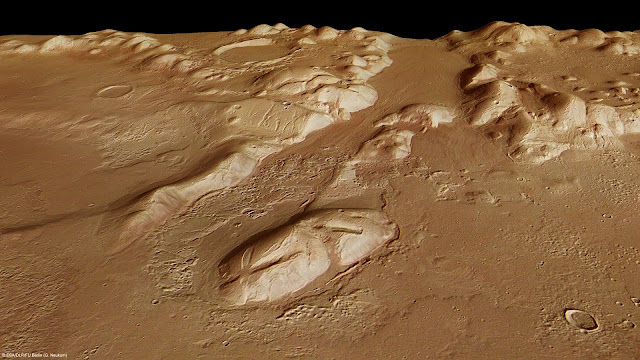-%20Plato%20crater%20Moon%20.png)
Le cratère Platon (2000m)
La Lune, Système solaire
In Plato Crater Moon, photographie retouchée sur appareil Nasmyth, 1855
Le relief
Platon (2000m de profondeur) est un cratère d'impact lunaire situé sur la face visible de la Lune. Il se trouve au nord-est de la Mare Imbrium et des Montes Teneriffe, à l'extrémité orientale des Montes Jura et à l'extrémité occidentale des Montes Alpes d'où partent des crevasses lunaires dénommées Rimae Platon. Au nord s'étend la Mare Frigoris. Le contour circulaire possède de nombreux pics qui donnent des ombres à l'intérieur du cratère. L'intérieur du cratère a un albédo, apparaissant lisse sans présence aucune d'impacts quelconques. Le cratère Platon est connu pour être un lieu de phénomène lunaire transitoire (PLT) consistant dans l'apparition d'une lumière ou d'une modification d'aspect de sa surface lunaire pendant une courte durée.
L'artiste
James Nasmyth est un mécanicien et astronome écossais, au talent artistique certain,. Fils du peintre Alexander Nasmyth, il montra de bonne heure de grandes aptitudes pour les mathématiques et la mécanique, travailla de 1829 à 1831 chez le constructeur Henry Maudslay, puis fonda à Particroft, près de Manchester, un important établissement qui prospéra rapidement sous le nom de fonderie Bridgewater et qu'il pourvut d'un outillage perfectionné.
Parmi ses nombreuses inventions, il faut surtout citer le marteau-pilon, dont il paraît avoir eu l'idée en même temps que le Français François Bourdon. On lui doit également une cuiller de sûreté pour les fondeurs, un ventilateur pour les mines, un laminoir, une machine marine, etc. Il s'était retiré en 1837 à Penshurst (comté de Kent), s'occupant avec passion d'astronomie et prenant, avec des appareils de sa construction, des photographies du Soleil et de la Lune, qui comptent parmi les plus remarquables qu'on ait jamais obtenues. Il a également inventé le télescope Nasmyth, une variante du Cassegrain.
2024- Gravir les montagnes en peinture





,%201837-1908%20Rolfe,%20W.%20J.%20(William%20James),%201827-1910-Astronomy_for_the_use_of_schools_and_academies_(1882)Copernicus%20crater-%20Library%20of%20Congress.jpg)














